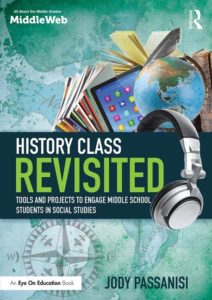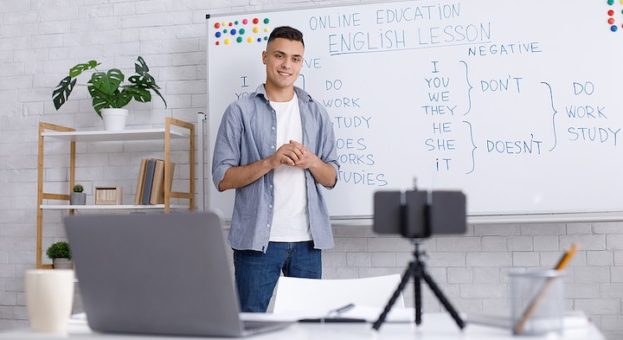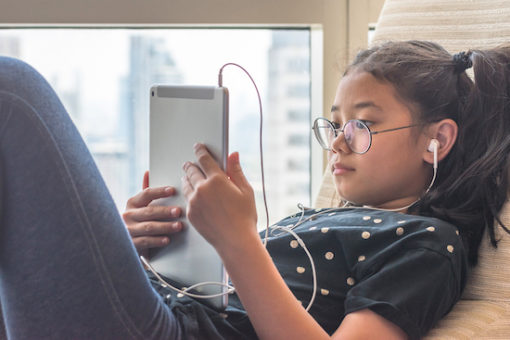Can Tech Replace the Classroom? Should it?
Writing a decade ago, Jody Passanisi and Shara Peters wondered if online learning could replace physical school. Now as they evaluate the costs to students of pandemic driven education, the teachers turned school leaders have their answer: Content in a human vacuum can’t sustain itself.
By Jody Passanisi and Shara Peters
Almost 10 years ago, we asked the following question, which was, at the time, hypothetical:
“Could an online learning system replace a classroom?”
In a 2012 article for Scientific American, we answered our own question: “Yes, it could. Will it? Most definitely not.”

Jody
When we wrote this, we were classroom teachers, prognosticating about the 2012 zeitgeist of concern amongst educators: so much technology. Indeed, at the time it felt like we were riding a giant wave of new technology initiatives. In a rush to adopt these new tools, many educators were using the tools for the tools’ own sake, not wanting their craft to appear outdated.

Shara
Others balked at the encroachment of tech tools onto their teaching territory. The question was in the air: could that technology eventually make classrooms and the in-person classroom learning experience obsolete? What would that mean for education?
At that time we strongly felt that – no, even as technology improves exponentially, classrooms won’t be replaced. We have now lived through a time period that caused us to question the purpose and method of everything we do, and that also threw us into the arms of technology as a necessary means to education’s ends.
Ten years and one pandemic later, the world has given us a chance to test our theory. We have seen what is lost when we don’t have access to the brick-and-mortar classrooms. We have felt the oxygen leave the room at the idea of going back to online learning, even for a few days.
Most students and educators across the country experienced this to varying degrees during the pandemic. It will be years before we understand the depths to which students were impacted from this paradigm shift in their education.
Our Reasoning in 2012
Ten years ago we laid out a simple argument for why online learning wouldn’t completely phase out in-person learning. The foundation of our argument was as follows:
● Classrooms aren’t just for disseminating information: students need to learn skills to unpack that information – evaluate it, analyze it and create their own understandings.
● In order to do all of the above, students need to be able to collaborate with other students and their teachers.
● Our economy is based more on service and face-to-face or at least interpersonal interactions rather than on manufacturing; students need to have the skills to collaborate with others.
● Education (of younger students especially) is as much about learning how to be a person in the world as it is about gaining academic knowledge and skills.
● Teachers are an invaluable resource and have been since forever; replacing teachers with tech would be ridiculous.
Now that the question is no longer a hypothetical, we can safely say that we agree with all of the above – and more.
Current Reasoning: Reflections from a Pandemic
Social and Emotional
Many students wilted during online learning. This isn’t to say that some kids didn’t enjoy or even thrive academically during distance learning, but they were in the minority. Things that we all took for granted before the pandemic – passing people in the hall, saying a brief hello, just being around other people – all of these things were gone. Students were learning in a social vacuum.
One mitigating factor were breakout rooms, which allowed students to interact with each other in small groups. But some students were so self-conscious on these virtual platforms that they couldn’t turn on their cameras. And many students knew, deep in their gut, that this was just not natural. It made it hard for them to buy in.
Early studies of the effects of the pandemic show that being younger (under 18) was a risk factor for increased mental health challenges (WHO, 2022). Students who are used to being around peers and trusted adults at school were missing a vital component of their support system. Seeing people through a screen, while better than nothing, is no substitute for being in-person.
During the pandemic students experienced a mental health crisis with self-reports of anxiety and depression doubling during that time (Richtel, 2021). Online school can’t be blamed for all of that increase – the pandemic itself brought about other challenges and major concerns that affected mental health – but we can be certain that the format of online schooling contributed to this increase.
Kinesthetic opportunities
Students are not meant to sit for eight hours straight. As much as we tried to mitigate students’ amount of time in front of a screen by assigning asynchronous work, it all came down to being close to a screen – students working on a device – even if not in an online class at the time.
Students who wanted to connect to their friends would also chat online or game online. At the end of the day, students would have a glazed look in their eyes. PE was a challenge on these online learning platforms – students would need to be pushed to go outside – even if they lived in an area where they were able to safely go outside or had PE as an offering in a distance learning environment.
For some students, the main exercise and movement they experience is in school – and online school is the antithesis of movement no matter how many Go Noodle, Simon Says, or other creative exercise and brain-break activities teachers designed or used creatively during the pandemic.
Interpersonal Skills
All of the small and big social interactions that students have in a day help them to learn how to be in the world with other people. These interactions are not always simple. Teachers, administrators, and other education professionals are there to facilitate student learning in this regard: when an issue comes up between students, teachers can give the students tools to solve the problem and help mediate challenges.
Without these opportunities to learn from interpersonal interactions, students remain in their own solipsistic bubble, not being challenged by others – and ultimately, not learning these vital interpersonal skills.
In the very tightly organized online classroom, interactions are planned – and very rarely by happenstance as would be the case for an interaction on the playground or the basketball court. Also: online, students don’t have the natural anchors of in-person learning. Walking away in the physical world is much harder than turning off your screen.
Access
All of these issues were, in some ways, issues faced by the privileged. Many students across the country didn’t have much access to technology, which resulted in learning loss and isolation. There isn’t yet equity in terms of technology and what’s available for ALL students.
Teachers
We are both administrators in independent schools in California. Supporting our teachers, and of course our students, during the pandemic was of the highest importance. The events of 2020 and 2021 burnt out our educators (Schabram & Heng, 2021). The pressures of hybrid classrooms (where both online and in-person students are present), Covid protocols, Covid fears, and the lack of normalized connections between colleagues and students were all a “motivation suck.”
To have online classrooms, you need online teachers – and after this experience, while having an online option can be incredibly helpful with health emergencies or inviting guests into classrooms, and other circumstances of the extenuating variety – teachers are likely not lining up to teach in this format.
Unintended Consequences of Online Learning
As administrators, we are deeply aware that students engage with tech differently now than they did before the pandemic. Middle grades students figured out early on that they could binge watch Netflix during class, and teachers had a harder time catching them. They got completely used to being able to message friends and search for content with no checks. They had backchannels on Discord and were more adept at getting around content blocks.
Ultimately, they developed the habit of splitting their focus amongst a number of different digital stimuli, all of which are designed to activate their dopamine levels more readily and simplistically than school and those key learning activities that require more complex engagement.
The number of bad tech habits students picked up is too great to list here, let alone the content they were exposed to that was beyond teacher and family control. Now that they are back in the classroom, we see students who cannot avoid multitasking. Along with that, we find an increase in technology-related infractions.
Resets are necessary but difficult to enforce as students’ tech use is often furtive, both at home and in the classroom. Students’ brains are not developed enough, nor do they have all the skills and tools, to have unfettered access to the Internet, games, and social media.
The absence of brick-and-mortar classrooms has also led to students who have lost even more of a sense of an awareness of others beyond what’s developmentally expected. Kids need so much more prompting to clean up after themselves, to take care of their classroom and school community.
Teachers need to re-teach certain basic community skills that help students to remember that they need to think before they speak, be aware of people around them, take responsibility for their actions, and look out for other members of their communities.
All of these so-called “soft skills” along with empathy, self-regulation, and community responsibility are cornerstones of classroom curricula. And while online learning allows for the delivery of content, albeit not necessarily in the most engaging way, there are little to no opportunities for students to practice these other skills in community.
Can online learning replace the classroom? Here’s the 2022 answer to the 2012 question: No. Not if we want students to grow up to care about the community and the world around them, and to be adept at moving through the world with a modicum of self- and other-awareness.
Final Thoughts
We are not saying that there isn’t a place for technology in the classroom – we are huge proponents of purposeful tech use à la the SAMR model (Puentedura, 2006). However, we’ve now tried the online classroom mode, and, when comparing that experience to in-person school, those benefits of in-person education – social connections, emotional support, interpersonal interactions, sense of responsibility to self and community and physical movement – cannot be overstated, especially for younger students.
Truly, learning is not just about knowledge and content – it’s the interactions that solidify that learning. It’s the feelings of being around people, in community, that can allow students to learn about themselves and one another. Content in a human vacuum can’t sustain itself. We’ve seen the future of online learning – and it’s just not sufficient for a full education.
Works Cited
Passanisi, J. and Peters, S. (2012, June 28). Teachers and administrators, don’t be scared of technology: It won’t replace the classroom. Scientific American Blog Network. Retrieved March 7, 2022, from https://blogs.scientificamerican.com/guest-blog/teachers-and-administrators-dont-be-scared-of-technology-it-wont-replace-the-classroom/
Puentedura, R. (2006, August 18). Transformation, Technology, and Education. Retrieved March 7, 2022, from http://hippasus.com/resources/tte/
Richtel, M. (2021, December 7). Surgeon general warns of Youth Mental Health Crisis. The New York Times. Retrieved March 7, 2022, from https://www.nytimes.com/2021/12/07/science/pandemic-adolescents-depression-anxiety.html
Schabram, K., & Heng, Y. T. (2021, April 28). Educators and Students Are Burned Out. These Strategies Can Help. Harvard Business Publishing Education. Retrieved March 7, 2022, from https://hbsp.harvard.edu/inspiring-minds/educators-and-students-are-burned-out-these-strategies-can-help
World Health Organization. (2022, March 2). Mental health and covid-19: Early evidence of the pandemic’s impact. who.int. World Health Organization. Retrieved March 8, 2022, from https://www.who.int/publications/i/item/WHO-2019-nCoV-Sci_Brief-Mental_health-2022.1

Shara Peters is the General Studies Principal at Pressman Academy in Los Angeles and has previously held roles at schools in Southern California including Teacher, Curriculum Director, and Head of School. She has written about education for Scientific American and Education Week, and co-hosted a podcast, “Find Yourself a Teacher,” along with Jody Passanisi. Shara was a 2019 recipient of the Pomegranate Prize from the Covenant Foundation, a national leadership award given to Jewish educators for exceptional service as emerging professionals in settings across the country.
Jody and Shara were the originators of MiddleWeb’s Future of History blog. Find their posts here.

































